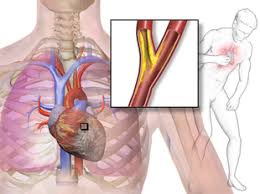Angina pectoris
Angina pectoris, commonly known as angina, is chest pain due to ischemia (a lack of blood, thus a lack of oxygen supply and waste removal) of the heart muscle, generally due to obstruction or spasm of the coronary arteries . Coronary artery disease, the main cause of angina, is due to atherosclerosis of the coronary arteries. There is a weak relationship between severity of pain and degree of oxygen deprivation in the heart muscle (i.e., there can be severe pain with little or no risk of a heart attack, and a heart attack can occur without pain).ClassificationStable anginaAlso known as effort angina, this refers to the more common understanding of angina related to myocardial ischemia. Typical presentations of stable angina is that of chest discomfort and associated symptoms precipitated by some activity (running, walking, etc.) with minimal or non-existent symptoms at rest. Symptoms typically abate several minutes following cessation of precipitating activities and reoccur when activity resumes. In this way, stable angina may be thought of as being similar to claudication symptoms.Unstable anginaUnstable angina (UA) is defined as angina pectoris that changes or worsens. It has at least one of these three features:1. It occurs at rest (or with minimal exertion), usually lasting >10 min;2. It is severe and of new onset (i.e., within the prior 4–6 weeks); and/or3. It occurs with a crescendo pattern (i.e., distinctly more severe, prolonged, or frequent than before).Microvascular anginaMicrovascular Angina or Angina Syndrome X is characterized by angina-like chest pain, but has different causes. The cause of Microvascular Angina is unknown, but it appears to be the result of poor function in the tiny blood vessels of the heart, arms and legs. Since microvascular angina isn't characterized by arterial blockages, it's harder to recognize and diagnose, but its prognosis is excellent. Signs and symptomsMost patients with angina complain of chest discomfort rather than actual pain: the discomfort is usually described as a pressure, heaviness, tightness, and squeezing, burning, or choking sensation. Apart from chest discomfort, anginal pains may also be experienced in the epigastrium (upper central abdomen), back, neck area, jaw, or shoulders. Angina is typically precipitated by exertion or emotional stress. It is exacerbated by having a full stomach and by cold temperatures. Pain may be accompanied by breathlessness, sweating and nausea in some cases. In this case, the pulse rate and the blood pressure increase. Myocardial ischemia comes about when the myocardia (the heart muscles) receive insufficient blood and oxygen to function normally either because of increased oxygen demand by the myocardia or by decreased supply to the myocardia. This inadequate perfusion of blood and the resulting reduced delivery of oxygen and nutrients is directly correlated to blocked or narrowed blood vessels.CauseMajor risk factors Age (≥ 55 years for men, ≥ 65 for women) Cigarette smoking Diabetes mellitus (DM) Dyslipidemia Family History of premature Cardiovascular Disease Hypertension (HTN) Kidney disease (microalbuminuria or GFR<60 mL/min) Obesity (BMI ≥ 30 kg/m2) Physical inactivityOther medical problems profound anemia uncontrolled HTN hyperthyroidism hypoxemiaOther cardiac problems tachyarrhythmia bradyarrhythmia valvular heart disease hypertrophic cardiomyopathy PathophysiologyAngina results when there is an imbalance between the heart's oxygen demand and supply. This imbalance can result from an increase in demand (e.g. during exercise) without a proportional increase in supply (e.g. due to obstruction or atherosclerosis of the coronary arteries).DiagnosisSuspect angina in people presenting with tight, dull, or heavy chest discomfort which is: 1. Retrosternal or left-sided, radiating to the left arm, neck, jaw, or back.2. Associated with exertion or emotional stress and relieved within several minutes by rest.3. Precipitated by cold weather or a meal.Some people present with atypical symptoms, including breathlessness, nausea, or epigastric discomfort or burping. These atypical symptoms are particularly likely in older people, women, and those with diabetes. TreatmentThe most specific medicine to treat angina is nitroglycerin. It is a potent vasodilator that makes more oxygen available to the heart muscle. Beta-blockers and calcium channel blockers act to decrease the heart's workload, and thus its requirement for oxygen. Nitroglycerin should not be given if certain inhibitors such as Sildenafil , Tadalafil ,or Vardenafil have been taken within the previous 12 hours as the combination of the two could cause a serious drop in blood pressure. Treatments are balloon angioplasty, in which the balloon is inserted at the end of a catheter and inflated to widen the arterial lumen. Stents to maintain the arterial widening are often used at the same time. Coronary bypass surgery involves bypassing constricted arteries with venous grafts. This is much more invasive than angioplasty.The main goals of treatment in angina pectoris are relief of symptoms, slowing progression of the disease, and reduction of future events, especially heart attacks and, of course, death.


 info@utopiapharma.com
info@utopiapharma.com
 Plot No. (2) Industrial Zone (A7) - formerly Zizinia - Cairo - Ismailia Road - 10th of Ramadan - Sharkia
Plot No. (2) Industrial Zone (A7) - formerly Zizinia - Cairo - Ismailia Road - 10th of Ramadan - Sharkia